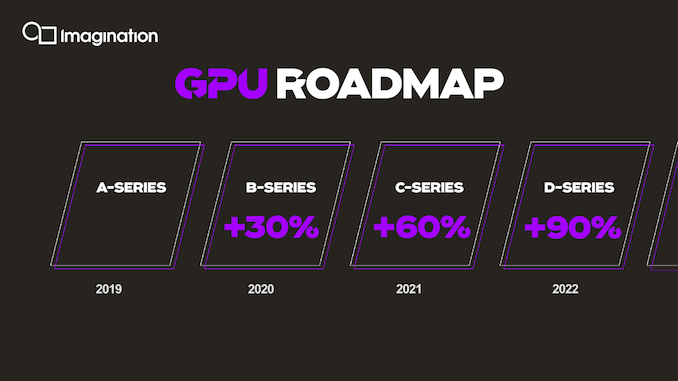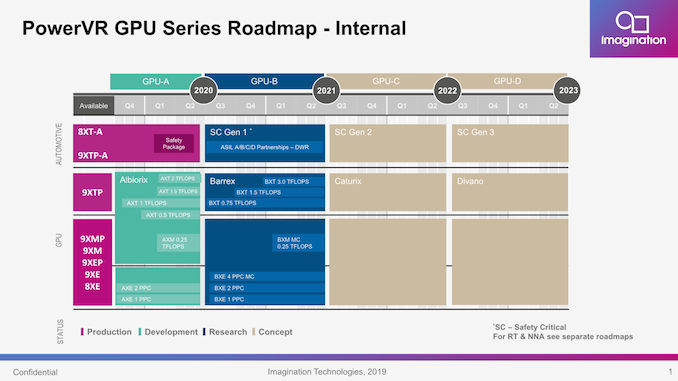Imagination Announces A-Series GPU Architecture: "Most Important Launch in 15 Years"
by Andrei Frumusanu on December 2, 2019 8:00 PM ESTFuture Roadmap & Final Thoughts
The new A-Series architecture means to represent a reset for Imagination’s product offerings, representing a bright new future for the company. The new GPU IP is certainly impressive in terms of the PPA metrics that it promises to achieve, and if realized, it does have ramifications for the wider industry and the competitive landscape.
But even if the A-series can deliver on all of Imagination's promises, the company can't stop there. The competition is continuing to refine and improve their designs, and so must Imagination. To that end, along with today's announcement of the A-series, Imagination is also publishing a very broad roadmap for the next few years, outlining the upcoming GPU generations and their expected performance gains. All of this is especially important for SoC designers, who want to know what's coming down the pipe before making the effort to switch IP vendors.
Imagination’s roadmap following the A-Series is seemingly very aggressive, promising yearly updates going forward, with large annual performance increases of 1.3x, or a 30% yearly compound annual growth rate. This is a much bigger goal than we’re used to historically, but it’s very much in line with the pace of progress we’ve seen from some vendors in the past, or even what Apple has managed to recently achieve over the last two generations.
For the A-Series, Imagination has adopted a public announcement schedule more similar to Arm’s, meaning that the A-Series has already been finished and licensed out to customers, with SoCs being designed and prepared to hit the market for 2020 – we’re assuming the latter part of 2020.
The B-Series is already well under way in terms of development and projected to be completed by next summer if the roadmap is to be taken as an accurate schedule, so at least Imagination has a strong path forward.
What’s important here for Imagination, is managing to actually achieve design wins for the new GPU IP in meaningful higher volume sockets. In terms of possible customers, it’s an increasingly small list, with most of them being the smaller Chinese SoC vendors such as RockChip, Unisoc (formerly Spreadtrum). Samsung is an unlikely client given their plans with AMD as well as custom GPU development, unless there happens to be some opportunity in the low and mid-range segments. HiSilicon likely is tied to Arm, if their plans of a custom GPU don’t pan out. This leaves MediaTek as one of the bigger clients, with the most opportunity and likelihood of adopting the A-Series. Holding onto more MediaTek SoC wins, instead of having them flip-flop between PowerVR and Mali, would be a big win for Imagination and its GPU group. With MediaTek now having re-entered the flagship SoC market, it seems like a very good match.
The wider semiconductor industry is said to be in an architecture revival phase, realizing the need for stronger designs in order to make up for decreasing yearly improvements in process performance. Imagination’s A-Series here seems to be a perfect example of such a revitalization, bringing with it massively impressive generational jumps. If the improvements pan out in practice, I do believe it could be a turning point for the company, and in the future we indeed might look back on it as being the most important launch in the company’s mobile history.












143 Comments
View All Comments
vladx - Wednesday, December 4, 2019 - link
Lol taking the words of a shady company like Apple as a fact, good one melgrosss.s.yu - Wednesday, December 4, 2019 - link
Championing a shady company like Huawei, good one vlad.name99 - Tuesday, December 3, 2019 - link
Andrei is as close to correct as one can hope to be.All we ACTUALLY know is that PowerVR has NEVER sued Apple. They said some pissed off things in a Press Release, then mostly took them back in a later Press Release.
And Apple said it would cease to pay to *royalties* to Imagination within a period of 15 months to two years.
It is possible that Apple created something de novo that's free and clear of IMG and that's that.
It's also possible that Apple paid (and even continues to pay?) IMG large sums of money that are not "royalties" but something else (IP licensing? patent purchase? ...).
We have no idea which is the case.
Apple is large enough that the money paid out could be hidden in pretty much any accounting line item. IMG is private so have no obligation to tell us where their money comes from.
mode_13h - Wednesday, December 4, 2019 - link
Yeah, it could've been a one-time lump sum payment. That's not technically "royalties".lucam - Tuesday, December 3, 2019 - link
Very true. If you were to run GFXBENCH on the new iPhone 11PRO with the A13, you will see that the gldrivers are all powervrs and IMGtc just the previous A12. Exactly the same. So in my mind the A13 still has some form of PowerVR design in it.vladx - Wednesday, December 4, 2019 - link
Don't kid yourself, Apple tried to buy IMG Tech on the cheap and I'm glad Imagination refused their insulting offer.lucam - Wednesday, December 4, 2019 - link
To be honest I think Apple still has some PowerVR design into the current chips, even in the A13, otherwise I can't explain why it appears the GLdrivers (PowerVR, img texture text etc) when I run the GFX bench....I think Apple and Imagination still have in somehow some form of good relationship behind...
s.yu - Tuesday, December 3, 2019 - link
"ISO-area and process node comparison"Goddamn. So refreshing to see a comparison under such standard conditions yet still showing up in footnotes. This is the industry that I recognize, not Huawei's deceitful comparison during the launch of GPU Turbo with age old design and age old architecture *without* due clarification for months.
Sychonut - Tuesday, December 3, 2019 - link
Now imagine this, but on 14+++++++. A beauty.mode_13h - Tuesday, December 3, 2019 - link
> There are very few companies in the world able to claim a history in the graphics market dating back to the “golden age” of the 90’s. Among the handful of survivors of that era are of course NVIDIA and AMD (formerly ATI), but there is also Imagination Technologies.Well... if you're going to count ATI, who got gobbled up by AMD, then you might also count Qualcomm's Adreno, which came from BitBoys Oy and passed through ATI/AMD.